Politics
Ten Things About Periyar Dravidian Parties Don’t Want You To Know
Aravindan Neelakandan
Mar 09, 2018, 04:58 PM | Updated 04:57 PM IST
Save & read from anywhere!
Bookmark stories for easy access on any device or the Swarajya app.
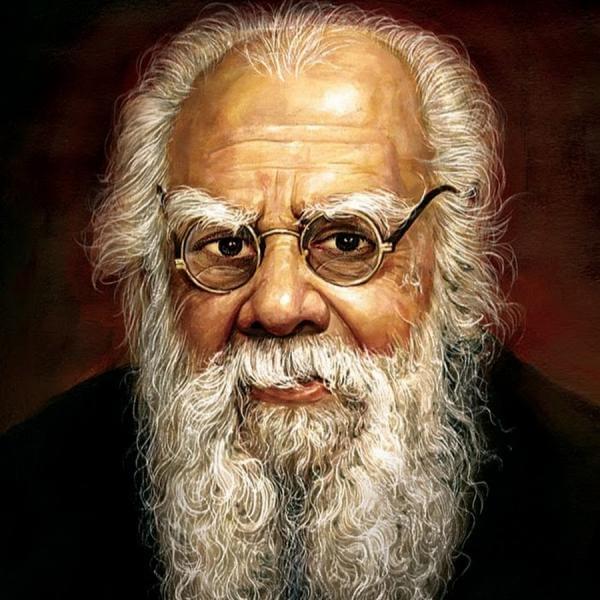
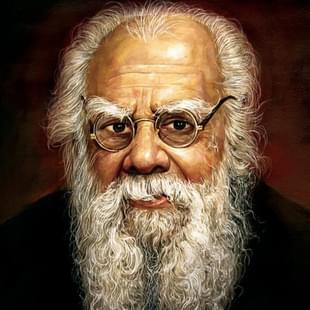
E V Ramasamy (1879-1973), popularly known as EVR, is hailed as ‘Periyar’ by his followers. He was a demagogue who used the social evils which were then prevalent, or perceived, as a capital for his propaganda. He was neither a rationalist nor a humanist. He was anti-Hindu and pro-British. By equating him to Bhimrao Ramji Ambedkar, many are doing a great disservice to the memory of Ambedkar, who was a great nation builder and a patriot.
Here are 10 facts which every Indian should know about EVR.
1. EVR advocated Nazi-style anti-Brahminism.
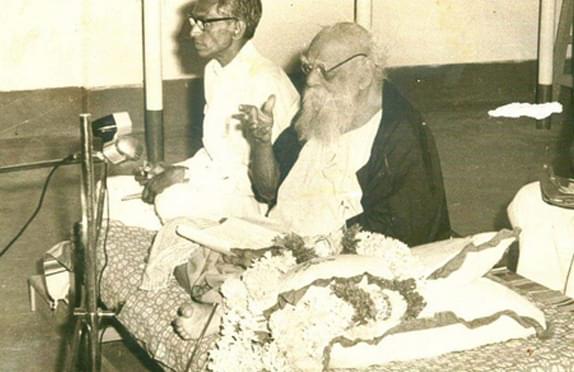
Many EVR apologists today indulge in the propaganda that EVR never advocated racial hatred against Brahmins. However, EVR was explicit in his agenda. The magazine he edited, published articles praising the ascendancy of Adolf Hitler and warned Brahmins in Tamil Nadu that they should learn from the plight of Jews in Nazi Germany and opt for course correction. Even after the fall of the Nazi regime, the approach of EVR, particularly when he addressed his cadre, was the same.
“Parpanan (a traditional honorific Tamizh term for twice-born, changed into a derogatory term by Dravidianists) should be driven away from this land,” EVR wrote on 29 January 1954. He further said, “However much a rationalist or atheist, if a person is a Brahmin he should not be allowed in our organizations” (20 October 1967).
A comrade of EVR’s, Ve Aanaimuthu revealed in his book that EVR told his cadre to rudely push away the Brahmin reporters when they came to his place. Sami Chidambaranar in his hagiography of EVR titled Tamizhar Thalaivar (“The leader of the Tamizhs”), writes:
To destroy caste discrimination burn the pictures of Nehru and Gandhi and also the Constitution of India. If all these methods fail to give us results, then we should start beating and killing the Brahmins; we should start burning their houses.
2. The perception of EVR as a liberator of women is propaganda fiction.
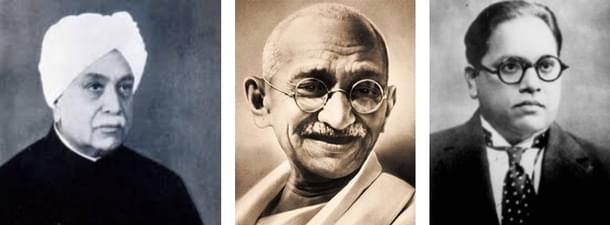
While EVR is hailed as a great liberator of women, there is barely any evidence of him participating in the most crucial women’s rights movement of his time – the struggle for Sarda Act. Brought on by Hindutvaite Har Bilas Sarda, the Act was supported by both Ambedkar and Gandhi. It ultimately banished child marriage in a giant leap in the fight for women’s rights. Many women from Tamil Nadu too fought for this Act to come to fruition. But EVR was nowhere associated with this struggle. Even his hagiographers accept that he was a feudal playboy (called ‘minor’) who used to visit local brothels. In fact, a hagiographer hails the following incident as a great rationalist strategy:
When the first wife of EVR Nagammai wanted to go to temple, EVR could not win over her by his arguments. So he secretly went to some of his ‘minor’ friends and showed them his first wife and told them that she was a new Dasi in the town asking them to make her consent to their desires. Consequently they started teasing and stalking her from the temple. Traumatised by this his wife stopped attending the temple. Later she came to know that this was a trick played by her rationalist husband.Tamizhar Thalaivar
In a much-circulated urban legend, EVR is said to have advised Dr Muthulakshmi Reddy, who was fighting for the abolition of the devadasi, advised her to counter Sathyamurthy in the legislative assembly with the argument that if being a devadasi was such a sacred position, then Sathyamuthy should start turning the women of his household/caste into devadasis. There is no archival or documentary evidence for this event. Further, this apocryphal urban legend belittles Reddy, who was more influenced by the Advaitic humanism of Sarada and Sri Ramakrishna and needed no advice from someone like EVR.
3. EVR was virulently anti-Scheduled Communities (SC).
EVR would clearly differentiate between SC non-Brahmins and non-SC non-Brahmins. He also made it clear that he identified himself with the welfare of non-SC non-Brahmins. He ranted in 1950 thus:
Today in the society there are three major divisions: Brahmins, Shudras and Panchamas. In this, the Brahmins because they are upper castes, are getting the concessions they need. The Panchamas because they are low castes are getting the concessions they need. It is the Shudras who are in the middle, who are suffering from lack of concessions.Viduthalai (16 April 1950)
This hatred for the SC community often made him say things that would make any ordinary person cringe.
4. He defamed Ambedkar by saying he was bribed by Brahmins.
This hatred for the SCs ultimately, and naturally, started flowing towards Ambedkar, whose stand on India’s national unity further infuriated him.
Today Dr Ambedkar had started taking the sterile stand of the North Indians that this nation should not be partitioned. I am afraid that in coming days he would also oppose the Dravidstan demand.Kudiarasu (8 July 1947)
Dr. Ambedkar alone somewhat fought for the Adhi-Dravidas (Scheduled Communities). They (Brahmins) went and told him, ‘If you want something for your problem, we may do something. But do not talk for others.’ Ambekdar also accepted that solution for his people. So in proportion to their population they made reservation for SC people in all departments. At least for his people he had got this. But if we ask reservation for us they call us ‘communalist’.Viduthalai (22 September 1951)
Even a year after the parinirvana of Ambedkar, EVR attacked him bitterly.
Ambedkar had some feeling similar to us. He asked me, ‘What can I do for your people?’ I gave him a lot of data. He started talking for us. At once Brahmins fixed a price for him. He asked 10 percentage reservation for his people in education and government jobs. They said ‘we will make it 15’. The Brahmins knew that even if 25 percentage was given even three or four persons of SC community would not come. And Ambedkar simply signed in that law. He did not bother about the problem of others.Viduthalai (11 November 1957)
With time, EVR’s hatred for Ambedkar increased. In his address on the occasion of Pongal in 1968, which was later published in his organisation’s official magazine, EVR accused Ambedkar of accepting “bribe from Brahmins in the form of reservation for his people (SC)” and saying the Constitution was made by the Brahmins.
5. EVR condemned Silappadikaram as Aryan propaganda tool.
In a speech made on 30 March 1951, EVR called Silappadikaram, the great Tamil epic written by llango Adigal, as “nothing but a propaganda tool of Aryans”. Condemning Tamil scholars who were conducting a seminar on the epic, he said:
Can a true Dravidian or a true Tamizh conduct a conference on Silappadikaram? I can only say that those who conduct a conference on this work are simply those who want to be certified as ‘good boys’ by the Brahmins. What is there in Silappadikaram, except the fact that it is a propaganda text of the Aryans? From the commencement to the end it is filled to the brim with Aryan concepts and nothing else.
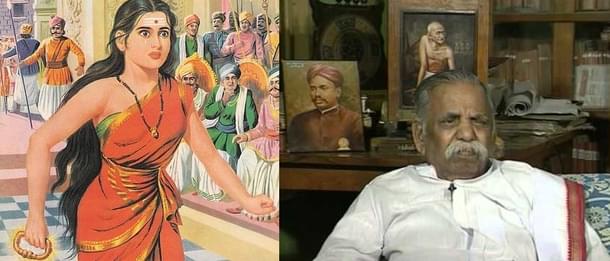
Tamil scholar Ma Po Sivagnanam (Ma Po Si) defended Silappadikaram against such attacks by EVR. In a rebuttal he penned against EVR, Ma Po Si wrote:
So (according to EVR) Kannagi, an individual woman fighting against the miscarriage of justice by a king is an Aryan concept; realizing the miscarriage of justice in his rule, the king voluntarily giving up his life is an Aryan concept; seeing the death of her beloved at once the queen spontaneously dying because of her love is an Aryan concept; Taming the pride of the northern kings who spoke ill of Tamizh is an Aryan concept; Harmonising the politically three-fold divided Tamizh provinces through literature by Illango that is Aryan concept; though born in the lineage of sex workers, Maathavai standing firm in her conviction and love - that is Aryan concept; Kannagi the heroine of the epic is shown as refusing to pray to the deity of love despite being suggested by her Brahmin friend - that is Aryan concept. If all these are Aryan culture set against the so-called Tamizh culture then let us hail that Aryan culture.
6. EVR had a love-hate relationship with Thirukkural and likened it to excreta.
EVR at one time (1948) praised Thirukkural, like every Dravidianist did, saying it was all rational and anti-Hindu. However, by 1950, he wrote that he also used to condemn Thirukkural as having thoughts contrary to rationalism. And people asked him if the Tamil text too would be gone, what book they would have left. “And I answered them thus: 'I am saying remove the excreta emanating bad smell from the room. And you are asking me if we remove this excreta what should we place in its place?’” (Viduthalai, 1 June 1950)
7. EVR “the economist” said prices of clothes had increased because SC women had started wearing jackets.
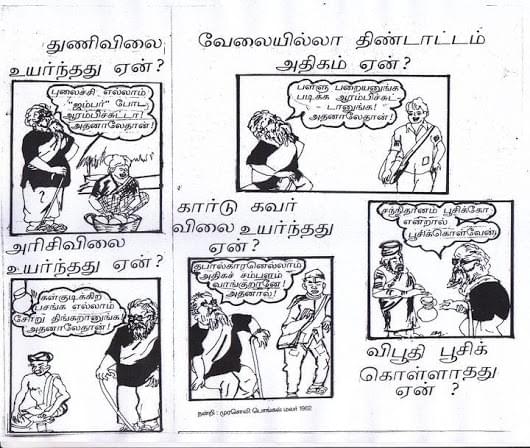
SC leaders in Tamil Nadu have for long accused EVR of saying, contemptuously, in a meeting that the cloth prices had gone up because the ‘Pariah’ caste women started wearing jackets. In 1963, many Ambedkarite magazines in Tamil Nadu had reported this speech. Anbu Ponnoviam, a venerated historian who had meticulously documented the lives of SC leaders and spiritual personalities, had written that as a keen observer of EVR from 1939, he was one of those who were shocked when he heard EVR offering Pariah women wearing jackets and Pariah men becoming literate as reasons for the rise in cloth prices and unemployment (Nasthikam, 2 March 1963).
A Chennai-based magazine, Ambedkar, in its 1963 November-December issue, pointed out that despite SC leaders strongly condemning EVR’s statement. The proof for the statement came from Dravidianists themselves when the Dravida Munnetra Kazhagam (DMK) magazine Murasoli published a cartoon highlighting the anti-SC mindset of EVR.
8. EVR sought the help of the British and Jinnah for his Dravidstan. But both treated him as a useful idiot.
It is a well-known fact that EVR and his movement were pro-British and they also supported the Muslim League in its pro-Pakistan demand. In an interview to a Tamil magazine, Anantha Vikatan, in 1965, EVR expressed how he had hoped that, given the pro-British stand of their movement, the British would hand over the authority to the Justice party. In his own words, “I went and told the British that it was not British honesty to hand over the power to them while we are the ones who have always supported you. The British smiled and said that they now knew only Hindu-Muslim difference and not Brahmin non-Brahmin difference. Then I went and saw Jinnah and asked for his help. He said that your bed (plan) looks good but it lacks the legs to stand on. And he told that only I had to look after my problem. The media wrote that Jinnah had tar-brushed the face of EVR.”
9. Kamarajar, the tallest nationalist non-Brahmin leader from Tamil Nadu, never accepted the racist and anti-Hindu views of EVR.
EVR apologists again indulge in propaganda and many have come to even believe that Kamarajar had respect for EVR and his worldview. In reality, Kamarajar consistently opposed EVR’s worldview. When EVR and his cohorts opposed the conference on Silappadikaram, Kamarajar, who attended and supported the conference, criticised the stand of EVR and his Dravidian movement.
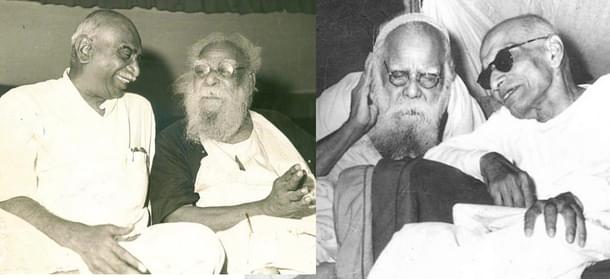
If love for the nation grows then the language will also flourish. Dravidianists criticize Tamizh literature but they seldom do anything positive. To be frank they are actually harming Tamizh language and culture. Why do we oppose the Dravidian movement because it is harming the Tamizh society. So we must oppose this movement. They are creating confusing by instigating Dravidian racial feelings. ... Dravidian movement opposes Purana-Ithihasas. Purana-Ithihasas instill in us sense of justice, Dharmic intelligence and love for the nation. Can we deem these as superstitious?Senkoal (“Sceptre”, a Tamil magazine, 1 July 1951)
Even when EVR expressed his support for Kamarajar in the 1957 election, Kamarajar came out with a statement. Sociologist Llyod Rudolph explains:
If DK canvassed votes for him out of their own free will, he could not possibly tell them he did not want their votes. On the other hand, he added that Congress could not countenance a communal organization, that is, one excluding or including members on some racial or case basis, and that he “wanted to make it absolutely clear he did not share the views of Mr. E.V.Ramaswami Naicker.”Indian Express, 14 February 1957, and The Hindu, 16 February 1957 and 10 March 1957: Llyod Rudolph, Urban Life and Populist Radicalism Dravidian Politics in Madras, The Journal of Asian Studies, Vol 20, No 3 (May 1961)
Then chief minister Kamarajar passed a new Dramatic Performance Act. It was specifically aimed at stopping the obscenely racist anti-Ramayana plays which M R Radha, a disciple of EVR, was staging. Later, when DMK came to power defeating Kamarajar, EVR in a speech before his death expressed his happiness at the defeat of Kamarajar.
10. EVR could never bring himself to condemn the massacre of landless SC labourers by non-Brahmin land owners in Keezhvenmani, Tamil Nadu.
On 25 December 1968, a group of 44 women and children, the families of SC agricultural landless workers striking for a wage hike, were burnt to death by henchmen of non-Brahmin landlords in a village in Thanjavur district of Tamil Nadu. EVR, in a statement condemning the incident, called it the result of a communist conspiracy against the then ruling DMK government. He said:
The workers should be taught to live with what they receive as wages. Instead of teaching them that the Communists are trying to instigate the workers into riots and rebellions. Because of that 42 persons have lost their lives. Both the left and the right Communists as well as the ultra-Communists are trying to somehow topple this government. ... Agriculturists of Eastern Thanjavur should not allow the evil force of Communists to spread in their area. Our people should support and strengthen our government instead of weakening it.
PS: I thank author and historian Sri Ma Venkatesan, the leader of state SC division of the Bharatiya Janata Party, who wrote The Two Faces of E V Ramasamy Naicker (Tamil, 2004). The sections on EVR’s views on Tamil literature, his hatred towards the SC people and his propaganda against Ambedkar are based on that book.
Aravindan is a contributing editor at Swarajya.





